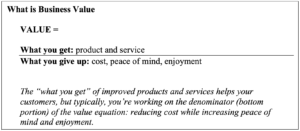So often, people do things because that’s what they’re “supposed to do.” Managers assign responsibilities as tasks to be checked off a list. But this approach to management keeps the employee in the dark, disconnected from what they’re actually contributing to the business and why it matters. When you focus instead on the business value, it causes people to think about what all those tasks lead to. It gives them the why.

Why Focus on Value?
The biggest benefit of changing the perspective to value is that it forces you and your team to focus on your customer and their benefits. It moves you past what you do to what customers get and give up. Why does this matter? When your organization focuses on what you do, you’ll do things the same way you always have done them. The only reason you might change is if you do something wrong or there’s a problem and it forces you to change.
By contrast, focusing on value opens up opportunities for improvement and gives you new paths to value contribution. Put simply, if you don’t focus on value, you’ll just end up doing the same thing over and over again.
Understanding Your Organization’s Value Chain
A value chain is officially defined as a set of connected activities that a firm operating in a specific industry performs in order to deliver a valuable product or service for the market. But in terms of your department, think of it this way:
My organization’s value chain is a set of activities we perform in order to deliver a valuable product or service for our customers (internal or external) at the smallest expense to cost, peace of mind and enjoyment.
To move employees from task focus to value focus, you need to connect them to your organization’s value chain:
- Determine what competencies your organization has that makes it uniquely qualified to deliver its value contribution. If your employees are just focused on what they do, they may have a hard time coming up with an answer. They won’t have a sense of their specialness or their strengths to be able to see what makes them uniquely qualified. If that’s the case, focus instead on answering the question, What are our unique competencies that very few other departments in this organization have that allow us to do this work? In other words, Why us?
- Connect employees to the value chain. Every employee has to connect to the value chain, and this is usually based on function. Every effort they perform should also contribute to the value chain; if it doesn’t, then they shouldn’t be doing it. If it needs to be done, then you have to uncover what it adds to the value chain. Even roles that provide secondary support should be connected. For example, an administrative assistant enables the person they support to do bigger things that contribute to the value chain.
To connect people to the value chain, list what each person produces and who their customer is. Describe it in a way that:
- Is inspirational and has some motivation and meaning to it (Example: The receptionist connects people with people.)
- Creates an opportunity for innovation and improvement
- Move people from completing tasks to adding value. Completing tasks is an end unto itself. Adding value always leaves room for improvement. Encourage employees to question what they do and how much value it provides to the customer. Let them think of ways to improve what they do, and reward them when they do so and increase their value contribution.
Linking people to the organization’s value chain will not only increase the value to your customers, it will decrease the amount of time you have to put into managing your employees. So make sure you’re giving them the why, not just giving them tasks to check off a list.

